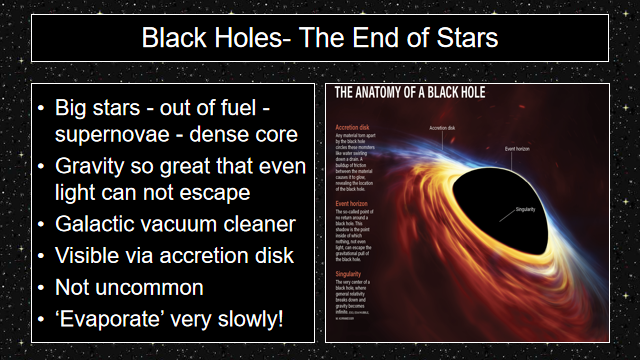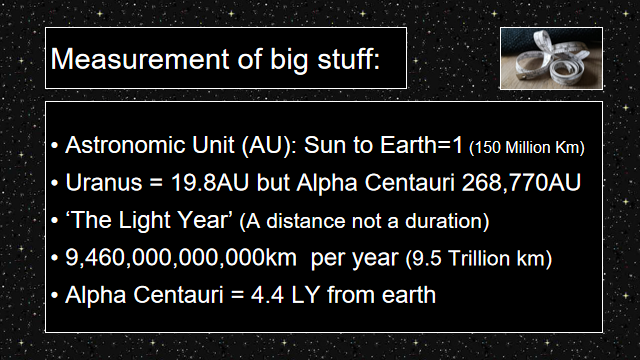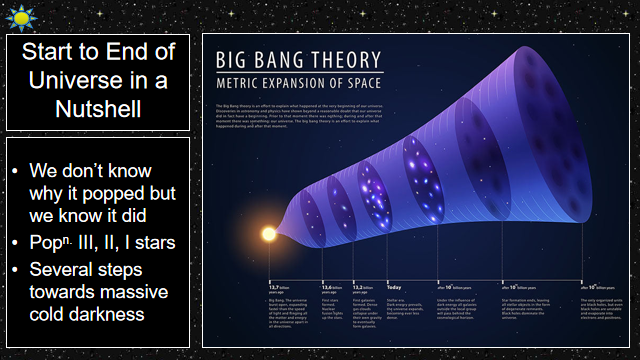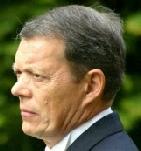From Earth to the edge of the Universe
Thu, Apr 11th 2024 at 7:00 pm - 9:00 pm
presented by Shaun Livesey
Club members please log in for more information.
11th April 2024 The Antithesis of Local – Everything from 62 miles up (the defn. of where Space starts) Shaun Livsey
Shaun started with a slide showing the position of the planets: Sun, Mercury, Venus, Earth, Mars, Jupiter, Saturn, Uranus and Neptune with relative sizes and showing how the Sun is very large compared with the rest. But continuing to show that our Sun is not so large compared with Betelgeuse and UY Scutti stars, the latter being 5 billion times the size of our Sun! However, Black Holes are by far the most massive individual objects in the Universe, but it all started with the ‘Big Bang’ 13.8 billion years ago which we know happened, but not WHY it happened. There is a stellar life cycle: birth, main sequence, old age, death and renewal. Gas (Plasma) from the Big Bang plus gas/dust from exploded stars and gravity does “its thing”, pulling diffuse gas together to create new stars which fuse atoms of hydrogen forming helium and spare energy. Black holes form at the end of especially large stars lives, when they run out of fuel and ‘supernovae’ (explode). With a super dense core, gravity is so great that even light cannot escape – a galactic vacuum cleaner! Visible only by their hot ‘accretion disc’, they are not uncommon and will be one of the last active objects at the end of time taking hundreds of millions of years to evaporate by a process called Hawking radiation.
We were then shown a slide of the periodic table with the question: if the Big Bang gave us only Hydrogen and Helium, where do the other 88 elements come from? It transpires that the fusion process within stars can combine smaller atoms together to form bigger and bigger atoms up to Iron. At this point no more energy is created and stars collapse and explode with heavier elements being created as a by-product. It was noted that the gold in the ring on your finger was formed billions of years before our sun was created in the death throws of an ancient and long dead star.
Then a change to the recently discovered Dark Matter and Dark Energy which make up more than 95% of the matter in the Universe. Looking far away is actually looking back in time. For example, light or radio communication would take 250,000 years to reach our nearest Galaxy and another 250,000 years for an answer back.
Distances are so great in space that new units of measurement have been created such as the Astronomic Unit (the distance between the Earth and the Sun- 150 million km) and the Light Year (the distance that light travels in one earth year- 9 trillion km). To demonstrate the vastness of space, Voyager 1 was recalled as being launched 47 years ago but has yet to reach a distance of 1 light day from Earth when the very nearest star is over 4 light years from Earth.
Many more amazing facts were touched upon to emphasis the vastness and age of the Universe we live in and constantly learn more about.
Shaun was asked: ‘Is there life out there?’, then referencing the Drake equation, the conclusion was “Yup” but it’s not going to be a quick-fire conversation!
Complimentary comments and questions flowed from our baffled members and Stan offered the vote of thanks saying that he found it difficult to understand how ‘something’ came from ‘nothing’ creating the Big Bang and everything that followed from that, but found the presentation thoroughly fascinating, but difficult to get ones head around and asked members to join him with an enthusiastic round of applause. AR
'What We Do' Main Pages:
If you like what we do as an organisation and are interested in volunteering with us, keeping up to date with our plans and future events then why not consider signing up as a friend of our Rotary Club
more
This is a monthly meeting open to visitors from Bingham, Radcliffe, Cotgrave and all villages in surrounding area.
moreThis committee are involved in planning now we can raise funds for our chosen charities
more
It's here that you can read what we've been up to in the last few months. For more information on our work in the local community, with our young people and internationally please access "what we do" section of this web site.
more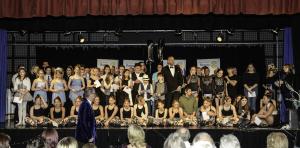
We have now successfully run this event for 10 years. Full reports of each year are available under this main page
moreOur International Committee is involved with Polio Plus - a Rotary initiative to eradicate Polio, World-wide; Sand dams; Aqua Boxes; Shelter Boxes; Collecting used spectacles, and many other projects
moreHere you can read about the many meetings we've had during our formation as a Rotary Club. The early years are a little short on detail...
more